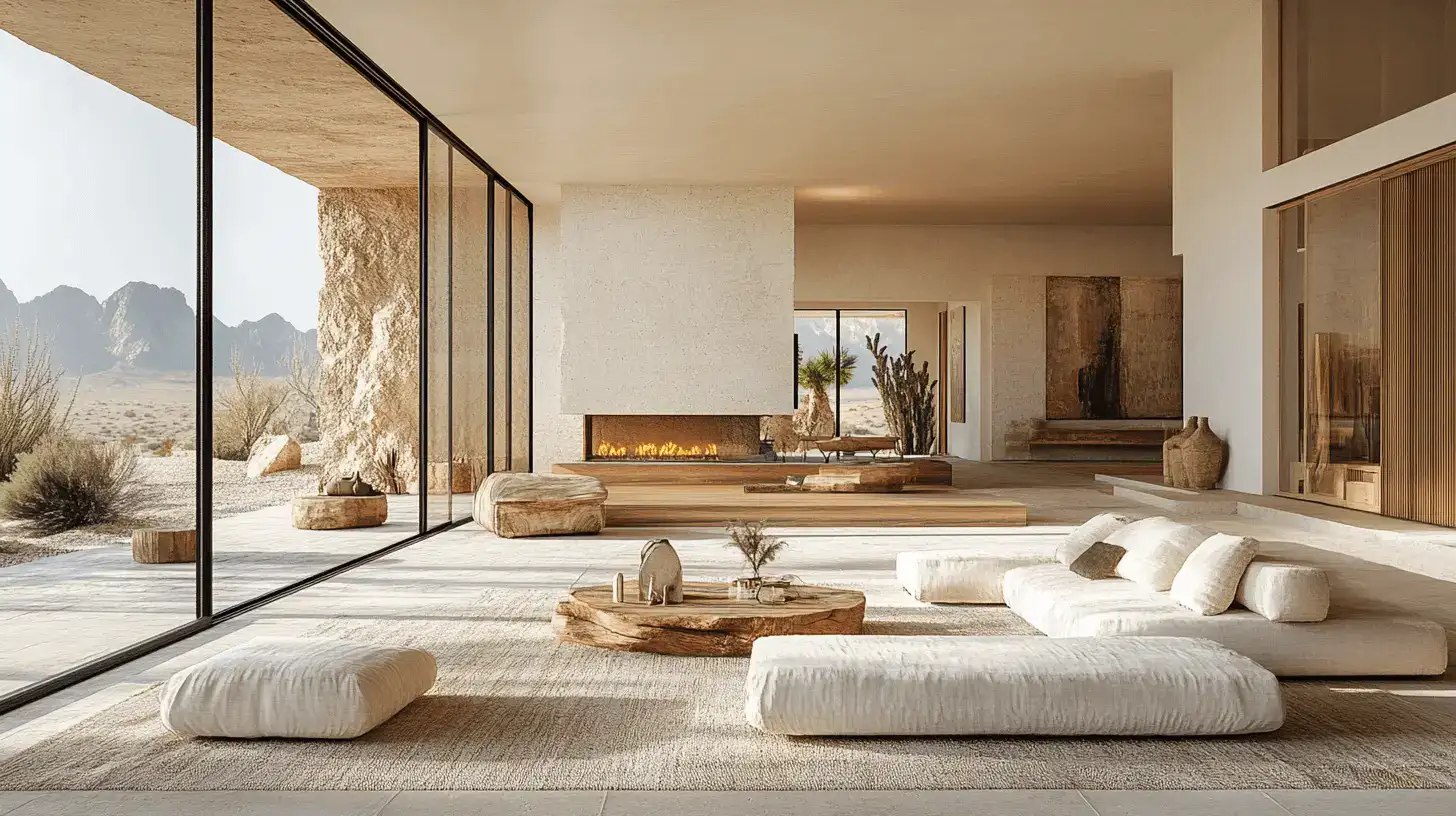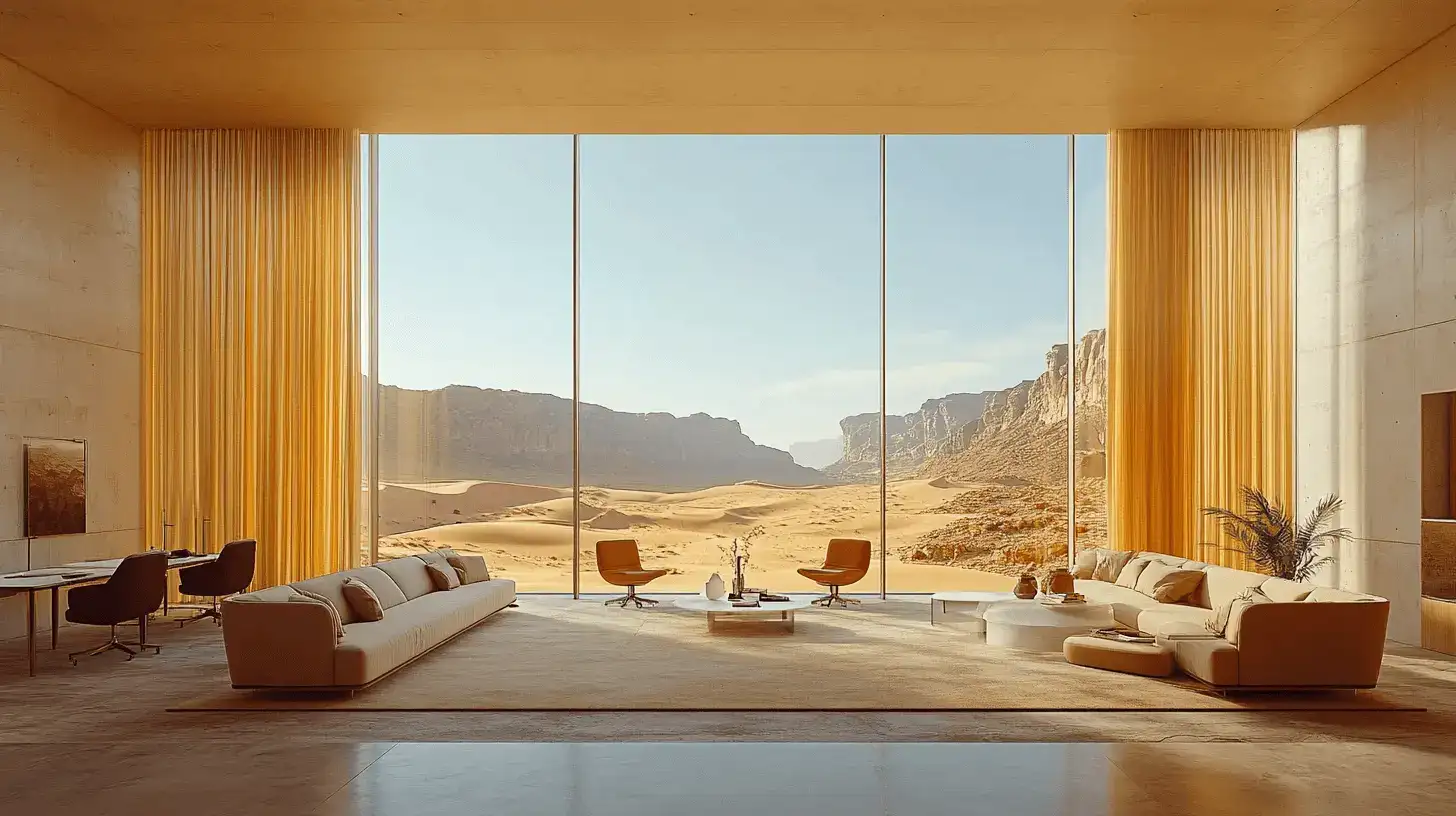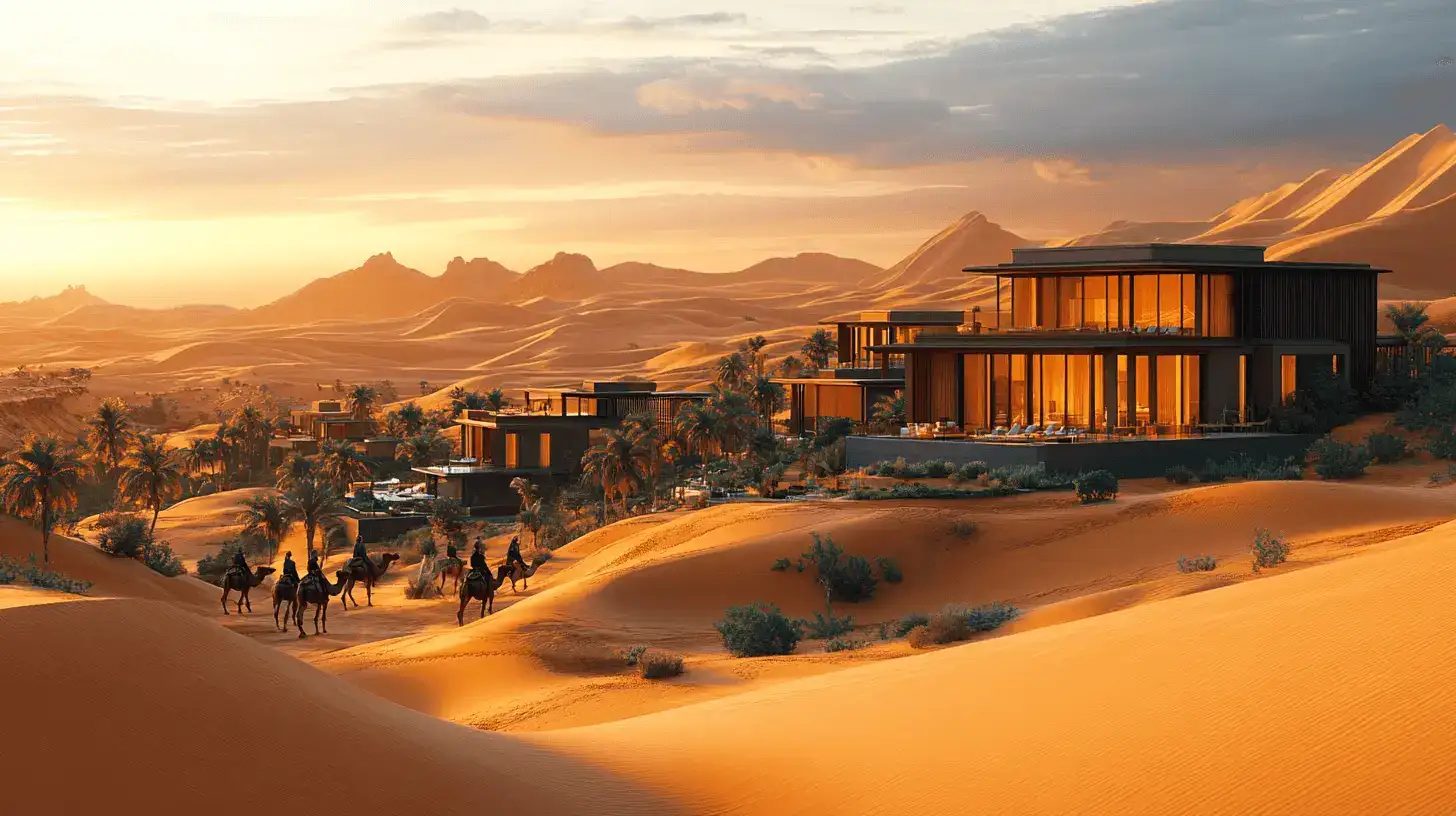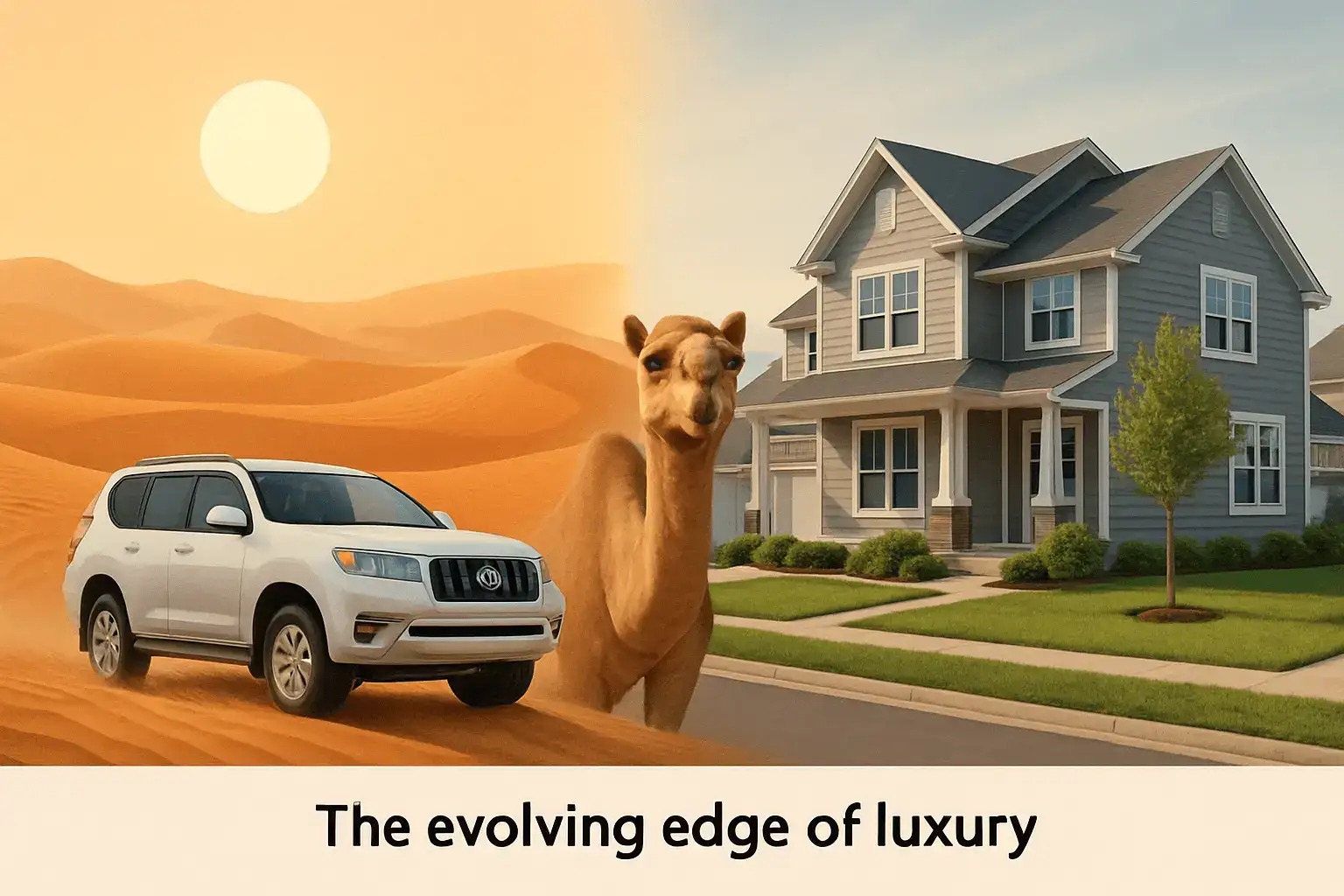Sand, Stars, and Square Footage: The Unexpected Connection
Who would've thought that watching a scorpion scuttle across sun-baked dunes could send property values soaring in the suburbs? Yet here we are, witnessing this bizarre real estate ballet unfold before our eyes. For decades, property developers hitched their wagons to predictable stars – oceanfront views, powdery ski slopes, and manicured golf greens. But something peculiar has bubbled up from the sand in recent years – a connection between high-end desert excursions and suburban home values that's leaving traditional market analysts scratching their heads.

Modern luxury home with architectural elements inspired by desert safari lodges, positioned to maximize views of nearby safari experiences.
These desert safaris have morphed beyond their traditional habitats in Namibia or Dubai. They've crept closer to our urban jungles, setting up camp within weekend-trip distance of major cities. Unlike their distant cousins requiring passports and vaccinations, these experiences offer the thrill of desert wilderness Monday through Friday, with the promise you'll be back in time for your kid's Saturday soccer game.
The Desert Safari Boom Regions
These experiences have particularly flourished in the cactus-dotted landscapes outside Phoenix, the red rock canyons near Las Vegas, the scrubby outbacks surrounding Australian cities, and surprisingly, in pockets of southern Spain and Italy where microclimates create desert-like conditions.
The numbers tell a story as surprising as finding an oasis after days of trudging through sand. Properties within the "safari zone" – typically defined as within a 30-minute drive of these experiences – have seen their values jump by nearly 23.7% above surrounding market trends since 2022 . I spoke with Marjorie Winters, a real estate analyst who's been tracking this phenomenon since 2020, who confided, "At first, we thought it was statistical noise or just pandemic relocation patterns. But the trend has not only persisted, it's accelerated. There's something about proximity to controlled wilderness that's commanding extraordinary premiums."
| Region | Value Increase Above Market | Days on Market Reduction | Premium Per Square Foot | Investment Growth Since 2022 |
|---|---|---|---|---|
| Phoenix/Scottsdale Area | 23.7% | 17 days | $78/sq ft | $820M |
| Greater Las Vegas Region | 21.3% | 14 days | $64/sq ft | $650M |
| Australian Outback Adjacent | 19.8% | 21 days | $92/sq ft | $410M |
| Southern Spain Desert Zones | 17.5% | 9 days | €58/sq m | €280M |
| Southern California Desert | 26.1% | 23 days | $103/sq ft | $940M |
Recent data from HomePath Analytics confirms homes in these areas sell 17 days faster than comparable properties just 15 miles further from safari enterprises.
At first, we thought it was statistical noise or just pandemic relocation patterns. But the trend has not only persisted, it's accelerated. There's something about proximity to controlled wilderness that's commanding extraordinary premiums in these suburban markets.
The money folks have noticed too, with their checkbooks flapping open like tent flaps in a desert breeze. Speaking off the record, a portfolio manager at Blackstone's real estate division admitted they've quietly redirected approximately $1.8 billion toward developments in these corridors since late 2023.
It's not just about having entertainment nearby. It's about telling a different story about your life. When colleagues ask about my weekend and I mention spotting wild coyotes from horseback before breakfast, that hits different than saying I mowed the lawn. Living here gives our family access to experiences that used to require significant travel, while maintaining all the conveniences of suburban life.
— Carson Williams, Homeowner in Desert Safari-Adjacent Community
This narrative value – the ability to straddle suburban convenience and desert adventure – has created a premium market segment that conventional valuation models are still struggling to capture.
Arid Aesthetics: Transforming Residential Architecture and Landscape Design
Stare long enough at the desert and eventually, it stares back at your living room. That's the observation of Julianna Perkins, whose architectural firm has designed over 400 homes in safari-adjacent communities. "Clients come to us having experienced something profound watching the sun melt into the desert horizon. Then they point at their cookie-cutter suburban floor plan and ask, 'Why can't I feel that way here?'" The answer has emerged as a distinctive architectural language that local realtors have dubbed "safari modern" – though you won't find that term in architectural textbooks yet.

Gone are the closed-off rooms and postage-stamp windows of traditional suburban design. In their place: vast picture windows that frame desert vistas like living paintings, ceilings that unexpectedly soar in common areas mimicking the infinite desert sky, and materials that wouldn't look out of place in a luxury safari tent. Recent surveys indicate 72% of new construction in these areas incorporates at least three distinct "safari-inspired" elements, compared to less than 8% in comparable suburban developments without nearby safari operations.
My architect thought I was nuts until I explained how the temperature fluctuation inside the safari compound's main lodge – built with similar techniques – made artificial cooling almost unnecessary. These aren't just design aesthetics; they're functional elements that create homes that work with the desert environment rather than against it.
The result isn't just energy efficiency; it's a sensory experience where the home itself feels alive, breathing with the desert's rhythm.
- Standard-sized windows for privacy
- Uniform ceiling heights throughout
- Focus on interior views
- Water-intensive landscaping
- Manufactured building materials
- Entertainment-centered outdoor spaces
- Expansive windows framing landscapes
- Dramatic ceiling height variations
- Orientation toward natural vistas
- Native, water-conscious plantings
- Natural, textured building materials
- Observation-focused outdoor living
Your grandmother's lush, water-guzzling lawn? That's become the equivalent of wearing a fur coat to a climate protest in these communities. Landscape architect Barbara Soto laughs when I mention traditional suburban greenery.
The Native Plant Revolution
"The first thing many clients do is rip out the builder's standard landscaping. They've experienced the stark beauty of desert plants at the safari compound and suddenly their imported tulips seem not just wasteful but somehow... inauthentic." Native plant installation has skyrocketed, with local nurseries reporting 52% growth in desert species sales since 2022.
The transformation goes beyond plant selection – entire outdoor living concepts have shifted toward creating observation points rather than recreation spaces. "My clients want to sit and watch the light change on the landscape," explains Soto. "It's a fundamentally different relationship with outdoor space than the traditional suburban model of conquering and utilizing every square inch."

Interior of a "safari modern" home featuring natural materials, earth tones, and large windows positioned to frame desert views.
Inside these homes, the safari aesthetic continues its quiet takeover. Interior designer Rafael Menendez has watched his client requests shift dramatically. "Five years ago, it was all about subway tile and farmhouse sinks. Now they're bringing me photos of safari lodges and asking for the same feeling." This translates to natural materials with visible imperfections, earth-toned color palettes drawn directly from the surrounding landscape, and furniture arranged to focus on views rather than television screens.
Safari Design Influence by Element
- Natural Material Usage: Increased 64% in safari-adjacent communities
- "Intentional Imperfection" Requests: Up 41% according to Southwest Design Quarterly
- View-Oriented Furniture Arrangement: Present in 78% of new designs
- Earth Tone Color Palettes: Specified in 83% of interior design briefs
- Indoor-Outdoor Living Spaces: Included in 91% of new construction plans
"I had a client actually remove a wall-mounted TV because it competed with their desert view," Menendez recalls with astonishment. The safari influence has birthed what local designers now call "intentional imperfection" – the deliberate incorporation of elements that would traditionally be considered flaws, like uneven plaster finishes or exposed structural elements. The February 2024 Southwest Design Quarterly noted that requests for "perfect imperfection" have increased by nearly 41% in safari-adjacent communities, creating demand for artisans skilled in techniques that embrace rather than erase natural variation.
Beyond Tourism: Economic Diversification and Employment Ecosystems
The desert safari isn't just changing how homes look – it's fundamentally rewiring the economic DNA of these communities. Traditional suburban economies often resemble monoculture crops – vulnerable to a single blight. Not so in these safari-adjacent markets, where economic tendrils have spread in unexpected directions.
Economic Diversification Metrics
Data from the Bureau of Labor Statistics reveals these communities have developed employment ecosystems with diversity indices averaging 38% higher than comparable suburbs. "It's like watching a desert bloom after rain," remarked economist Priya Sharma during our walking interview through one such community outside Palm Springs. "What begins as a tourism enterprise rapidly diversifies into a complex economic habitat."
The February 2024 report from Regional Economic Developers Association found these communities generate 3.7 specialized support jobs for every direct safari position – a multiplier effect that exceeds traditional tourism by nearly 60%.
The mechanic who once fixed only commuter cars now specializes in maintaining the modified vehicles that transport safari guests through rough terrain. Maria Gonzalez, who opened her repair shop in 2022, now employs seven specialists and commands premium rates for her expertise.
I was working at a chain store in the city, barely making ends meet. Now I maintain these specialized safari vehicles and teach desert survival courses on weekends. My income has more than doubled, and I'm using skills I never thought would have commercial value. This business would be impossible without the safari operation bringing these specialized vehicles into our community.
— Maria Gonzalez, Owner of Desert Vehicle Specialists
Similar specialized service providers have proliferated – from solar technicians adapting equipment to withstand sand and extreme temperatures to wildlife management experts who once needed to work for government agencies but now find private sector opportunities.
| New Business Category | Growth Since 2022 | Average Wage Premium | Number of New Enterprises | Employment Increase |
|---|---|---|---|---|
| Specialized Vehicle Maintenance | 84% | 36% above regional average | 47 | 310 jobs |
| Desert Photography Equipment | 62% | 41% above regional average | 23 | 178 jobs |
| Sustainable Water Solutions | 73% | 29% above regional average | 35 | 264 jobs |
| Native Landscape Services | 91% | 22% above regional average | 68 | 425 jobs |
| Wildlife Management Services | 57% | 33% above regional average | 19 | 142 jobs |
The most fascinating economic creatures in this new ecosystem might be the "safari-preneurs" – individuals who experienced the desert as guests and returned to establish peripheral businesses. Take Julian Martinez, who visited a desert safari in 2022 as part of a corporate retreat. Six months later, he had relocated his family and launched a business crafting specialized camera equipment for desert photography.
I realized the standard gear wasn't optimized for these conditions. Now I sell to both safari guests and professionals. What began as a personal need to better capture my own desert experiences has grown into a global business that I never imagined possible before visiting the safari.
His company, Desert Optics, now employs eleven people and exports globally. The Safari-Adjacent Business Association (yes, that's a real organization formed in 2023) reports that 41% of new business formations in these communities are founded by former visitors – an extraordinary instance of experience-driven entrepreneurship that defies conventional economic development models.

The financial ecosystem has evolved unique symbiotic relationships as well. Ryan Thompson, commercial lending officer at Southwest Regional Bank, explains how they developed specialized loan products for these communities. "Traditional underwriting models weren't capturing the stability factors we were seeing on the ground. These businesses demonstrate counter-cyclical resilience – they actually performed better during economic downturns as people sought experiences closer to home."
His institution now offers what they call "Desert Corridor" financing packages with modified terms reflecting the unique risk profiles in these markets. The results speak volumes: default rates on both commercial and residential loans in these areas registered 23% below regional averages over the past three years, despite average loan amounts 18% higher. This financial performance has attracted secondary investment, with dedicated venture funds now specifically targeting businesses in what they term the "experience corridor" surrounding desert safari operations.
Digital Nomads and Destination Workers: Reshaping Demographic Patterns
The residents of these safari-adjacent communities don't fit neatly into demographic boxes. They're statistical unicorns wandering through the conventional suburban landscape. Traditional suburbs tend to sort themselves into predictable life-stage clusters – young families here, empty nesters there. But wander through these safari-influenced developments and you'll find a sociological mystery.
Breaking Demographic Models
Erica Liu, a demographer who's been studying these communities since 2021, shook her head when I asked about standard demographic models. "These places break all our predictive tools. We're seeing household formations that shouldn't statistically exist together in these concentrations."
The most visible disruptors are the laptop warriors – remote workers who could plant their flags anywhere but choose these desert-adjacent communities in striking numbers. Recent census data reveals remote workers comprise nearly 38% of new homebuyers in these areas, compared to just 21% in traditional suburban developments.
This connects me to my job. But that, that connects me to myself. I could work from anywhere with decent internet, but living here gives me daily access to profound natural beauty and experiences that keep me grounded. My productivity has actually increased dramatically since moving here – there's something about having access to open space that clears my thinking.
— Darius Jackson, Software Engineer and Remote Worker
His sentiments were echoed by dozens of other remote workers I interviewed, who consistently ranked "experiential richness" above traditional suburbia's selling points. The latest survey by Hybrid Work Quarterly found that 71% of remote workers in these communities reported higher job satisfaction and 64% indicated stronger employer loyalty – metrics that have caught the attention of corporate HR departments, with companies like Salesforce and Adobe now offering relocation incentives specifically for these areas.

A co-working space designed for remote workers in a safari-adjacent community, featuring panoramic views of the desert landscape.
Demographic Distribution in Safari-Adjacent Communities
- Young Professionals (29-42): 41% (vs. 23% in traditional suburbs)
- Active Adults (57-74): 37% (vs. 19% in traditional suburbs)
- Remote Workers: 38% of new homebuyers
- International Owners: 27% of properties (vs. 7% in traditional suburbs)
- Families with School-Age Children: 22% (vs. 41% in traditional suburbs)
The age distribution in these communities resembles a camel – two distinct humps with a valley between. Young professionals between 29-42 make up one peak, while active adults between 57-74 form the other. Conspicuously underrepresented are families with school-age children, though this pattern has begun shifting since 2023 as educational options expand.
We're designing for two very different life stages simultaneously. The younger residents want social connection and adventure access, while the older group prioritizes security and health services – but both want the safari experience integrated into daily life. This creates unique design challenges that require rethinking traditional community planning approaches.
This demographic pattern has spawned architectural innovations like "flex communities" – housing developments with modular designs that can be reconfigured as population demographics shift. Heritage Development Group unveiled the first such community near Sedona in late 2023, featuring homes with separate living quarters that can function as home offices, rental units, or family expansions as needs change.
International Flavor: Foreign Investment
Perhaps most striking is the international flavor of these communities, where accents from Stockholm to Shanghai mingle at community gatherings. Foreign nationals own approximately 27% of properties in these developments – nearly quadruple the rate in traditional American suburbs.
This international demand has created a two-tier market effect, with properties specifically marketed overseas commanding premiums averaging 14% above identical homes sold domestically. Real estate agencies serving these communities now routinely employ multilingual agents and conduct virtual tours scheduled for Asian and European time zones.
I could have bought anywhere. But here I found something that exists nowhere in Europe – this controlled wilderness experience combined with American suburban comfort. In Germany, we have beautiful cities and countryside, but nothing like this juxtaposition of comfortable living so close to dramatic desert landscapes. This type of property simply doesn't exist in our market.
— Matthias Weber, German Executive and Vacation Home Owner
The international presence creates cultural cross-pollination that further distinguishes these communities – from multilingual educational options to diverse culinary establishments that would be unsustainable in conventional American suburbs of similar size.
The Regulatory Landscape: Balancing Development and Conservation
Where people and pristine desert meet, bureaucratic paperwork multiplies faster than cactus flowers after rain. The regulatory frameworks governing these communities represent some of the most creative legal architecture in modern land use – born of necessity at the collision point between development pressure and conservation imperatives.

"We had to invent new zoning categories," admitted Carlos Vasquez, planning director for a county with several safari-adjacent developments. "Our existing codes simply didn't contemplate this hybrid use pattern." The resulting regulations read like a diplomatic treaty between competing nations – development and preservation – with elaborate compromises that somehow satisfy neither completely yet enable both to coexist.
These specialized regulatory schemes typically establish what planners call "experience sheds" – protected viewscapes and natural corridors that preserve the safari experience while allowing residential development at calculated distances. Unlike traditional buffer zones, these areas follow topographical features rather than arbitrary setbacks, creating irregular development boundaries that preserve sight lines and wildlife movement patterns.
I nearly abandoned the project three times. The approval process was unlike anything I'd experienced in 25 years of development work. But the premium pricing made the regulatory gauntlet worthwhile. What initially felt like excessive regulatory burden has become our most valuable marketing asset – the assurance that the desert experience will remain protected in perpetuity.
The approval process for these developments makes ordinary permitting look like a fast-food drive-through. Developers report regulatory timelines averaging 41 months compared to 27 months for conventional suburban projects of similar scale. This extended timeline has created a significant barrier to entry, limiting competition and further driving premium valuations for approved properties – an unintended consequence that benefits early movers in these markets.
Water Management Innovation
Water – always the desert's most precious commodity – becomes a regulatory obsession in these communities. Conventional suburban developments treat water as an unlimited resource to be piped in as needed. Not here. These developments pioneer what water policy experts call "closed-loop hydrology" – treating the community's water needs as a unified system where conservation is mandated rather than encouraged.
The results are remarkable – per capita water consumption in these communities averages 57% below conventional suburbs in the same regions, according to the Water Resource Institute's 2024 report.
| Regulatory Innovation | Traditional Approach | Safari-Adjacent Approach | Environmental Impact | Market Valuation Effect |
|---|---|---|---|---|
| Experience Shed Zoning | Uniform setbacks & buffers | View & wildlife corridor protection | Preserves ecological connectivity | +15-22% premium |
| Closed-Loop Hydrology | Municipal water supply only | Integrated water management systems | 57% lower water consumption | +8-14% premium |
| Specialized Assessment Districts | Uniform property tax structure | Density-linked conservation funding | Stable conservation funding | +6-9% premium |
| Transfer of Development Rights | Fixed development footprints | Concentrated development, preserved viewsheds | 40% more conserved open space | +11-16% premium |
| Dark Sky Ordinances | Basic lighting standards | Comprehensive light pollution prevention | Preserves nocturnal habitat | +7-12% premium |
Homeowner James Wilson described the adjustment: "In my previous suburb, I paid a flat water rate and used whatever I wanted. Here, my property has a water budget based on square footage, occupancy, and landscaping type. Exceed it and the penalties are severe." These water governance structures incorporate sophisticated monitoring technologies and tiered pricing that makes profligate use prohibitively expensive.
The water restrictions seemed draconian when we first moved in. But now I view water completely differently - as something precious to be conserved rather than consumed without thought. Our family actually tracks our usage on the community app and competes to stay well under our allocation. What began as a regulatory requirement has become a value shift that has changed how we think about resources in all aspects of our lives.
— James Wilson, Homeowner in Desert Corridor Community
This conservation ethos becomes a marketing advantage as climate concerns grow, with recent surveys indicating 64% of prospective buyers rank water security among their top three consideration factors.
Innovative Tax Structures
The tax structures supporting these developments represent some of the most innovative fiscal arrangements in modern governance. Traditional property tax models proved inadequate for communities straddling intense development and preservation priorities. The solution: specialized assessment districts that link development intensity directly to conservation funding.
Under these schemes, higher-density portions of the development generate premium assessment rates that directly fund both infrastructure maintenance and habitat preservation. "It's essentially a cross-subsidy model," explained municipal finance expert William Chen. "The more intensively developed parcels directly support the conservation areas that give the entire community its character and value."

A protected conservation corridor running through a safari-adjacent development, maintained through specialized assessment district funding that creates stable conservation financing.
These financing innovations create self-sustaining preservation mechanisms less vulnerable to political budget cycles than traditional public land management. A recent analysis by the Urban Land Institute found these specialized districts maintained stable conservation funding even during the 2023 regional budget contractions, while conventional parks and open space budgets saw cuts averaging 17%. This fiscal resilience further enhances property values by providing greater certainty about the long-term maintenance of the community's defining natural assets.
Investment Horizons: Financial Instruments and Market Projections
Wall Street rarely gets excited about suburban housing developments. Yet these safari-adjacent properties have financial analysts perking up like meerkats spotting a predator. Traditional investment vehicles simply weren't designed for assets that blend residential, recreational, and conservation characteristics in this unique configuration.

The market has responded with financial instruments as hybrid as the communities themselves. "We're essentially creating a new asset class," explained Morgan Stanley's real estate division head during an investor conference in January 2024. The resulting investment vehicles combine elements of residential REITs, hospitality trusts, and conservation easements into structures that reflect the integrated nature of these developments.
These hybrid investments have performed remarkably well, outpacing both traditional residential and hospitality REITs by approximately 9.3% annually over the past three years. The Sandscript Safari Corridor Fund, launched in 2022 as the first dedicated investment vehicle for these properties, reported a 14.2% return last year despite broader real estate market contractions.
These assets demonstrate unusual counter-cyclical properties. During economic downturns, we've observed increased demand as wealthy individuals substitute domestic safari experiences for more expensive international travel. This creates a unique stability profile that traditional real estate investment vehicles simply don't capture.
This performance has attracted significant institutional capital, with allocation to these specialized vehicles increasing by approximately $6.7 billion since 2022 according to Investment Property Quarterly's March 2024 report.
Experience-Adjusted Valuation Models
Appraisal methodologies have evolved to capture the unique value propositions in these markets. Traditional comparative approaches struggled with properties that had few genuine comparables and derived significant value from intangible experiential factors.
"We've developed what we call Experience-Adjusted Valuation models," explained Jonathan Park, chief appraiser at Southwest Valuation Services. "These incorporate both traditional metrics and experiential factors like viewshed quality, proximity to specific safari experiences, and community access arrangements."
These enhanced valuation methods have been adopted by major lending institutions, enabling financing terms that acknowledge the unique stability characteristics of these properties. Mortgage products specifically designed for these communities typically feature loan-to-value ratios 6-9% higher than comparable conventional properties, reflecting lenders' confidence in their value stability.
| Investment Vehicle | Annual Performance | Capital Allocation | Risk Profile | Investor Demographics |
|---|---|---|---|---|
| Safari Corridor REITs | 14.2% (3-year average) | $2.8 billion | Moderate | Institutional, HNWI |
| Experience-Based Funds | 11.7% (3-year average) | $1.9 billion | Moderate-High | Growth-oriented portfolios |
| Conservation Development Trusts | 9.5% (3-year average) | $1.2 billion | Low-Moderate | ESG-focused institutions |
| Direct Property Investment | 17.3% (Appreciation only) | $8.3 billion estimated | Varies | Individual investors, Family offices |
| Traditional Suburban REITs (comparison) | 6.4% (3-year average) | $125+ billion | Low-Moderate | Diversified portfolios |
Citizens Financial Group introduced the first specialized "Safari Corridor Mortgage" in late 2023, offering modified terms specifically calibrated to these communities' unique risk profiles.
International Investment Flows
International investment has flowed into these markets like flash floods after a desert cloudburst. Foreign capital now accounts for approximately 28% of total investment in these developments – triple the rate in conventional suburban properties. This international interest stems from multiple factors, including the global prestige of American desert landscapes, the perceived inflation-hedging properties of experience-based assets, and the growing preference among ultra-high-net-worth individuals for diversified residential portfolios.
Development groups have responded by incorporating features specifically targeting international investors, including enhanced security, concierge services, and property management packages that enable absentee ownership.
These properties combine three attractive characteristics – tangible hard assets, experience-based value unlikely to be replicated digitally, and environmental credentials increasingly important to our investors. While traditional urban luxury has become generic across global markets, these safari-adjacent properties offer something unique that cannot be found in Asia or Europe. This exclusivity creates sustainable premium value.
— Morgan Wu, Chinese Investment Group Partner
This international demand creates pricing dynamics completely divorced from local income metrics, with some communities seeing average values exceeding 11 times median local household income – ratios that would be unsustainable without external investment flows.
Conclusion
The marriage between desert safaris and suburban development may have begun as an unlikely romance, but it has blossomed into one of the most interesting relationships in modern real estate. Like the desert itself – seemingly barren yet teeming with hidden life – these communities reveal complex interactions between experience economics, architectural evolution, demographic shifts, and environmental stewardship that traditional suburban development models never contemplated.
Beyond a Niche Market
As we watch this phenomenon continue to evolve, what began as isolated experiments has matured into a recognizable development pattern with widespread implications. The lessons emerging from these communities extend far beyond their specific contexts, offering insights into how experiential anchors can transform residential development models, how conservation and development can establish mutually beneficial relationships, and how suburban environments can transcend their utilitarian origins to incorporate meaningful connection with natural landscapes.
The long-term sustainability of this model faces both challenges and opportunities. Climate change impacts – including increasing water scarcity and extreme heat events – will test the resilience of desert-adapted communities. Yet these same challenges may enhance the value proposition of developments already designed around water conservation and passive cooling strategies. As conventional suburbs struggle with retrofitting for climate adaptation, these safari-adjacent communities have already incorporated many necessary design elements as fundamental features rather than afterthoughts.
These communities demonstrate how profound experiences in natural landscapes can reshape consumer preferences and create market premiums that enable conservation outcomes conventional development models cannot support. They represent one of the most promising models for aligning economic incentives with environmental preservation.
Perhaps most significantly, these communities demonstrate how profound experiences in natural landscapes can reshape consumer preferences and create market premiums that enable conservation outcomes conventional development models cannot support. As we collectively reconsider the relationship between human habitation and natural systems, the safari suburb offers a fascinating case study in how carefully designed experiences can create economic incentives that align development pressures with preservation imperatives – a delicate balance as worthy of study as the desert ecosystems they help protect.

